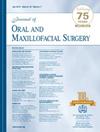How Does Thrombocytopenia Affect Outcomes in Head and Neck Cancer Surgery With Free Flap Reconstruction?
IF 2.6
3区 医学
Q2 DENTISTRY, ORAL SURGERY & MEDICINE
引用次数: 0
Abstract
Background
Thrombocytopenia is associated with a variety of medical comorbidities seen in patients with head and neck cancer. However, it remains unclear if and how thrombocytopenia affects surgical outcomes.
Purpose
The purpose of this study was to measure the association between thrombocytopenia and 30-day adverse outcomes in patients undergoing head and neck cancer surgery with free flap reconstruction.
Study design, setting sample
This was a retrospective cohort study using the 2012 to 2022 American College of Surgeons National Surgical Quality Improvement Program databases. Patients undergoing resection and free flap reconstruction for malignant pathology of the oral cavity, oropharynx, hypopharynx, larynx, and salivary glands were included. Patients undergoing emergency surgery or with missing outcomes data were excluded.
Predictor/exposure/independent variable
The predictor variable was platelet count coded as a binary variable: <150k/μL (thrombocytopenia) or >150k/μL.
Main outcome variable
The primary outcome variable was return to the operating room for free flap salvage or hematoma evacuation coded based on International Classification of Diseases diagnoses.
Covariates
Covariates were categorized into demographic (age, sex), medical (hypertension, diabetes), and perioperative (concurrent procedures, reconstructive modality).
Analyses
Descriptive, bivariate, and bootstrapped multiple logistic regression statistics were performed to evaluate the association between thrombocytopenia and adverse outcomes. Youden J analysis was used to identify a platelet value at which complications were more likely to occur. An alpha of P < .05 was significant.
Results
A total of 4,993 subjects met the inclusion criteria. There were 281 subjects with thrombocytopenia (5.63%) and 213 who underwent reoperations (4.30%). In bivariate analysis, thrombocytopenia was the only significant risk factor for reoperation, and these subjects were 1.74 times more likely to return to the operating room (P = .015, relative risk = 1.74, 95% CI 1.11 to 2.71). In multivariate analysis adjusting for study covariates, thrombocytopenia was independently associated with 1.82 times greater odds of return to the operating room (P = .026, OR = 1.82, 95% CI 1.11 to 3.26). Cut point analysis suggested that a platelet value less than 136,000/μL was a risk factor for return to the operating room.
Conclusions and relevance
Thrombocytopenia was independently associated with return to the operating room following ablative head and neck cancer procedures with free flap reconstruction.
血小板减少症如何影响头颈癌游离皮瓣重建手术的预后?
背景:血小板减少症与头颈癌患者的多种合并症有关。然而,目前尚不清楚血小板减少症是否以及如何影响手术结果。目的:本研究的目的是测量接受头颈癌游离皮瓣重建手术的患者血小板减少与30天不良结局之间的关系。研究设计,设置样本:这是一项回顾性队列研究,使用2012年至2022年美国外科医师学会国家手术质量改进计划数据库。包括因口腔、口咽部、下咽、喉部和唾液腺的恶性病理而行切除和游离皮瓣重建的患者。接受紧急手术或缺少结局数据的患者被排除在外。预测变量/暴露/自变量:预测变量为血小板计数,编码为二进制变量:150k/μL。主要结局变量:主要结局变量为返回手术室进行游离皮瓣保留或血肿清除,根据国际疾病分类诊断编码。协变量:协变量分为人口统计学(年龄、性别)、医学(高血压、糖尿病)和围手术期(同期手术、重建方式)。分析:采用描述性、双变量和自举多重逻辑回归统计来评估血小板减少症与不良结局之间的关系。使用约登J分析来确定血小板值,该值更容易发生并发症。alpha值P < 0.05具有统计学意义。结果:共有4993名受试者符合纳入标准。血小板减少281例(5.63%),再手术213例(4.30%)。在双变量分析中,血小板减少是再次手术的唯一显著危险因素,这些受试者返回手术室的可能性是1.74倍(P = 0.015,相对风险= 1.74,95% CI 1.11 ~ 2.71)。在调整研究协变量的多变量分析中,血小板减少与1.82倍的返回手术室的几率独立相关(P = 0.026, OR = 1.82, 95% CI 1.11至3.26)。切点分析提示血小板值低于136000 /μL是返回手术室的危险因素。结论和意义:血小板减少与消融头颈癌手术后自由皮瓣重建返回手术室独立相关。
本文章由计算机程序翻译,如有差异,请以英文原文为准。
求助全文
约1分钟内获得全文
求助全文
来源期刊

Journal of Oral and Maxillofacial Surgery
医学-牙科与口腔外科
CiteScore
4.00
自引率
5.30%
发文量
0
审稿时长
41 days
期刊介绍:
This monthly journal offers comprehensive coverage of new techniques, important developments and innovative ideas in oral and maxillofacial surgery. Practice-applicable articles help develop the methods used to handle dentoalveolar surgery, facial injuries and deformities, TMJ disorders, oral cancer, jaw reconstruction, anesthesia and analgesia. The journal also includes specifics on new instruments and diagnostic equipment and modern therapeutic drugs and devices. Journal of Oral and Maxillofacial Surgery is recommended for first or priority subscription by the Dental Section of the Medical Library Association.
 求助内容:
求助内容: 应助结果提醒方式:
应助结果提醒方式:


